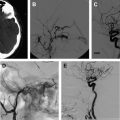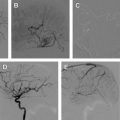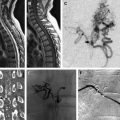Stroke is the third leading cause of death in the United States. Intracranial atherosclerotic disease plays a role in cerebrovascular accidents, with well-characterized modifiable and nonmodifiable risk factors. Surgical bypass has so far not proved to be superior to medical therapy. Both medical and endovascular therapies for intracranial atherosclerosis have evolved since the initial off-label use of cardiac devices for its treatment. Initial reports on the results of stent placement for symptomatic high-grade intracranial atherosclerotic disease were initially encouraging. However, debate remains as to the optimal treatment of symptomatic intracranial atherosclerotic disease.
Key points
- •
Intracranial atherosclerosis is an important cause of ischemic stroke.
- •
Modifiable and nonmodifiable risk factors exist.
- •
Systemic anticoagulation does not confer any significant advantage compared with antiplatelet medications.
- •
Surgical bypass has so far not proved to be better than medical therapy, although further trials are necessary to determine whether subgroups of patients exist who may benefit.
- •
Angioplasty and stenting so far has not proved to be better than maximal medical therapy, although further trials are necessary to determine whether subgroups of patients exist who may benefit.
Introduction
The estimated prevalence of strokes in 2006 was 6.4 million adults, with an incidence of about 795,000 new or recurrent strokes, 87% of which were ischemic. Intracranial atherosclerotic disease (ICAD) is responsible for an estimated 40,000 to 60,000 ischemic strokes per year in the United States, and has been identified as the sole cause of ischemic stroke in 8% to 9% of patients. According to the US Centers for Disease Control and Prevention, the death rate in 2010 for stroke was 42 per 100,000.
Race as a nonmodifiable risk factor has been well characterized. African American, Asian, and Hispanic populations have a higher incidence of intracranial disease compared with white people, who suffer more frequently from extracranial disease. However, men have a tendency toward extracranial atherosclerosis, and develop intracranial disease at an earlier age than women. The rate of disease progression in women is more rapid than in men. Thus, the male/female incidence rate changes with age: 1.25 at ages 55 to 64 years; 0.76 at 85 years and older. In an asymptomatic Japanese population, age, hypertension, and diabetes mellitus were identified as risk factors for intracranial stenosis. Because reports of ICAD prevalence are based on different methodologies (g, population, screening, autopsy) and imaging modalities (g, computed tomography angiography, transcranial Doppler, magnetic resonance (MR) angiography, digitally subtracted angiography (DSA)), it is likely that the prevalence exceeds stated values.
The precise role of smoking has been difficult to characterize. Although smoking is a demonstrable risk factor for extracranial carotid atherosclerosis, in a study of 1200 asymptomatic patients, smoking was not identified as a risk factor for ICAD. Current smokers have a risk of ischemic stroke twice that of nonsmokers.
Metabolic syndrome, a constellation of atherosclerosis risk factors linked to insulin resistance, has been associated with intracranial stenosis. Diabetes mellitus, hypertension, and dyslipidemia contribute to intimal medial thickness, which in turn is an early marker of atherosclerosis. The odds ratio of developing intracranial atherosclerosis increased with each additional component of metabolic syndrome.
Introduction
The estimated prevalence of strokes in 2006 was 6.4 million adults, with an incidence of about 795,000 new or recurrent strokes, 87% of which were ischemic. Intracranial atherosclerotic disease (ICAD) is responsible for an estimated 40,000 to 60,000 ischemic strokes per year in the United States, and has been identified as the sole cause of ischemic stroke in 8% to 9% of patients. According to the US Centers for Disease Control and Prevention, the death rate in 2010 for stroke was 42 per 100,000.
Race as a nonmodifiable risk factor has been well characterized. African American, Asian, and Hispanic populations have a higher incidence of intracranial disease compared with white people, who suffer more frequently from extracranial disease. However, men have a tendency toward extracranial atherosclerosis, and develop intracranial disease at an earlier age than women. The rate of disease progression in women is more rapid than in men. Thus, the male/female incidence rate changes with age: 1.25 at ages 55 to 64 years; 0.76 at 85 years and older. In an asymptomatic Japanese population, age, hypertension, and diabetes mellitus were identified as risk factors for intracranial stenosis. Because reports of ICAD prevalence are based on different methodologies (g, population, screening, autopsy) and imaging modalities (g, computed tomography angiography, transcranial Doppler, magnetic resonance (MR) angiography, digitally subtracted angiography (DSA)), it is likely that the prevalence exceeds stated values.
The precise role of smoking has been difficult to characterize. Although smoking is a demonstrable risk factor for extracranial carotid atherosclerosis, in a study of 1200 asymptomatic patients, smoking was not identified as a risk factor for ICAD. Current smokers have a risk of ischemic stroke twice that of nonsmokers.
Metabolic syndrome, a constellation of atherosclerosis risk factors linked to insulin resistance, has been associated with intracranial stenosis. Diabetes mellitus, hypertension, and dyslipidemia contribute to intimal medial thickness, which in turn is an early marker of atherosclerosis. The odds ratio of developing intracranial atherosclerosis increased with each additional component of metabolic syndrome.
Natural history
The rate of radiographic disease progression is variable. In a retrospective review of 23 patients who underwent serial angiography with moderate or severe atherosclerosis (average follow-up time 26.7 months), those without carotid bifurcation disease were more likely to have intracranial disease progression; overall, 40% of intracranial stenoses progressed, 20% regressed, and 40% were unchanged. This finding is similar to that seen in patients assessed using transcranial Doppler (average follow-up time 21 months): 35% disease progression, 7% regression, 45% unchanged (inconclusive in 14%).
The severity of ischemic injury is variable. Intracranial large-artery atherosclerotic stroke shows higher MR angiography–diffusion weighted imaging mismatch and lower hypoperfusion than other stroke subtypes, although the penumbra volume was similar among all stroke subtypes. This finding is hypothesized to be caused by the presence of better collaterals in intracranial large-artery atherosclerotic–related strokes.
The Groupe dEtude des Stenoses Intra-Craniennes (GESICA) study examined patients symptomatic from greater than 50% stenosis of intracranial vessels and found an annual risk of transient ischemic attack (TIA) or stroke in the affected area of 19.2% (annual risk of TIA 12.6%; stroke 7%). A 2-year event rate of 60.7% was seen in patients with more severe lesions.
Mortality seems to vary based on which vessel is affected: annual mortality of 6.8% for middle cerebral artery (MCA) stenosis; 11.6% for vertebrobasilar stenosis; 12.4% for intracranial internal carotid artery (ICA) stenosis.
Medical therapy
The Warfarin-Aspirin Symptomatic Intracranial Disease (WASID) trial was a retrospective study of symptomatic patients with greater than 50% stenosis of a major intracranial artery, comparing the efficacy of warfarin with aspirin for the prevention of major vascular events. The initial analysis revealed a stroke rate of 10.4 per 100 patient years in those taking aspirin, compared with 3.6 per 100 patient years in those taking warfarin. However, when similar patients were assessed in a randomized, prospective study (the comparison of warfarin and aspirin for symptomatic intracranial arterial stenosis), the rate of death from nonvascular causes, major hemorrhage (ie, brain, gastrointestinal, and so forth) and myocardial infarction was significantly higher in those receiving warfarin, without conferring a therapeutic advantage in stroke prevention compared with aspirin, causing the trial to be stopped prematurely. Over 2 years, the rate of ischemic stroke in patients with greater than 50% stenosis of intracranial vessels was 17.2% to 19.7%, higher than that observed in other trials (8% to 14%) assessing other causes of stroke. In the 2006 subgroup analysis, patients thought to be at exceptionally high risk for ischemic events were studied separately to establish whether certain groups of patients may benefit from systemic anticoagulation. These subgroups included vertebral artery stenosis, basilar artery stenosis, and failed thrombotic therapy. The investigators concluded at the end of this analysis that, even in patients in potentially high-risk subgroups, warfarin did not provide significant benefit.
In a post hoc analysis of 287 patients from the WASID trial, the degree of collateral circulation predicted risk of stroke. There was a statistically significant difference in the presence of collaterals in those with moderate stenosis: 23% of women and 8% of men. However, the rate of disabling or fatal strokes was equivalent in patients with either moderate or severe stenoses. Although any collaterals in the setting of moderate stenosis was a significant predictor of stroke, there was a protective effect in patients with both severe stenosis and extensive collaterals.
Medical therapy versus surgical bypass
In 1985, the initial results of the Extracranial-Intracranial (EC-IC) Arterial Bypass Trial were published, in which 1377 patients with symptomatic severe stenosis or occlusion of the internal carotid and middle cerebral arteries were randomized to best medical treatment (714 patients) or surgical bypass (663 patients) ( Table 1 ). In the medically treated arm, 36% of those with distal ICA stenosis and 24% of those with MCA stenoses suffered a stroke despite receiving aspirin. Despite these findings, the study failed to prove that surgery decreased the number of strokes. Eighteen percent of the medical patients and 20% of the surgical patients went on to have a single stroke, whereas 10% and 11% respectively of patients had a second stroke. A common criticism of this trial is that it failed to identify the subgroup of patients for whom bypass was thought to be the most effective: patients with poor collateral circulation. As neuroimaging has improved, identification of these patients has become possible.
| Type of Study | Number of Patients | Outcome | |
|---|---|---|---|
| EC-IC Arterial Bypass Trial | Prospective randomized | 714 medical 663 surgery | EC-IC bypass not effective in preventing cerebral ischemia in patients with atherosclerotic disease in the carotid and middle cerebral arteries |
| COSS | Prospective randomized | 98 medical 97 surgery | EC-IC bypass surgery plus medical therapy compared with medical therapy alone did not reduce the risk of recurrent ipsilateral ischemic stroke at 2 y |
More recently, the Carotid Occlusion Surgery Study (COSS) was designed to evaluate these patients with hemodynamic cerebral ischemia based on positron emission tomography measurements of oxygen extraction fraction. One-hundred and ninety-five patients were randomized, 97 to surgery and 98 to the medical arm. The trial was terminated early because it failed to show benefit against medical therapy in this subgroup of patients with symptomatic carotid occlusions. Further investigation has been suggested to evaluate cognitive and functional benefits in patients who have undergone surgical revascularization, rather than stroke risk reduction alone.
Stay updated, free articles. Join our Telegram channel

Full access? Get Clinical Tree






